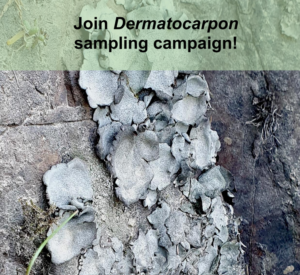Dermatocarpon
What is Dermatocarpon?
The Leather lichens
Fungi in the genus Dermatocarpon (Leather lichens) are large and conspicuous lichens (fungi growing symbiontically with green algae). Typical for this genus is that their fruiting bodies are tiny and completely immersed in the lichen thallus. Only the black openings (ostioli) of the spherical spore producing structures (perithecia) are visible without cutting the thallus. These small black dots are evenly dispersed over the surface of the large and leathery thallus. The combination of these characters separate Dermatocarpon species from other lichens on rocks. In N-America the colloquial name “stippleback lichens” makes reference to black ostioli, while the name “leather lichens” (mostly used in Europe) refers to the tough texture of the (moist) thallus.
Some of the species, such as the freshwater species Dermatocarpon luridum (which turns from light brown or grey to bright green when wet) are easy to recognize in the field. Such species can often be verified based on a photo record. Most of the other species however have morphological look-alikes and DNA sequencing is required to assign an observation unambiguously to one of the several cryptic species within larger species aggregates such as the Dermatocarpon miniatum group.
You can learn more on the genus from the materials below.
Why is this genus interesting for FunDive?
The genus Dermatocarpon contains about 10 described species in Europe (25 worldwide) and several infraspecific taxa, but DNA-sequencing has shown, that some of these morphotaxa represent species aggregates with distinct phylogenetic patterns within and there is evidence that highly similar morphological types have evolved several times independently. This situation creates difficulties in the unambiguous identification and naming of specimens which belong to morphologically cryptic species or fall into one of several genetically separate groups of morphological look-alikes. All Dermatocarpon species are slow growing and sensitive to physical disturbance e.g. by natural disasters, but also anthropogenic influences such as the “cleaning” of walls, rock climbing or the installation of stream bank enforcements. The sub-alpine freshwater species Dermatocarpon arnoldianum and D. rivulorum have also been suggested as sensitive indicators of climate change effects.
Almost all the sequenced specimens of European Dermatocarpon are from Central and NW-Europe and very little is known on the genetic diversity of the genus in Southern and Southwestern Europe. Collections from Portugal, France, Italy and Greece are therefore particularly welcome for the FunDive-project and they will enhance our understanding of the distribution patterns and threats for these distinctive lichens.
Where can you find species of Dermatocarpon?
Dermatocarpon lichens are typically found on hard rocks, which do not move – they are excellent indicators of long habitat stability and sensitive to the effects of natural disasters or restoration activities on anthropogenic structures such as walls and castle ruins. Some species are restricted to the splash water zone of boulders in clean streams and cold mountain lakes, others occur in water seepages of cliffs, on old walls, castles and ruins, in cracks or on the top of boulders in rocky pastures and steppe-like open habitats.
By reporting your findings, you will add to the knowledge of these species and your records will be important contributions to nature conservation.


